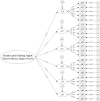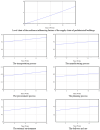Analyzing resilience influencing factors in the prefabricated building supply chain based on SEM-SD methodology
- PMID: 39075145
- PMCID: PMC11286961
- DOI: 10.1038/s41598-024-65271-2
Analyzing resilience influencing factors in the prefabricated building supply chain based on SEM-SD methodology
Abstract
The supply chain for prefabricated buildings (PB) currently grapples with pressing challenges. In order to ensure the safe and stable development of the prefabricated building supply chains (PBSC), this study aims to identify the key factors and internal mechanisms affecting the PBSC, and propose a supply chain resilience enhancement mechanism, so as to promote the sustainable development of the PB industry. The study combined a literature review and survey data to identify key resilience factors in PBSC. A Structural Equation Model (SEM) was used to explore the relationships between these factors. System dynamics were applied to create a simulation model, assessing the resilience impact level and conducting sensitivity analysis. The results show that the transportation and procurement processes are the most significant factors influencing supply chain resilience. The external environmental factors wielded a more pronounced impact on the overall evaluation of supply chain resilience than the delivery and use processes, but delivery and use processes are more sensitive. The study uses the Pressure-State-Response (PSR) model to suggest strategies for enhancing supply chain resilience. This study contributes to more sustainable and efficient construction practices by offering an innovative theoretical framework to analyze the factors influencing PBSC resilience and proposing enhancement strategies.
Keywords: Influencing factors; Prefabricated building supply chain; Resilience; Structural equation model; System dynamics.
© 2024. The Author(s).
Conflict of interest statement
The authors declare no competing interests.
Figures








Similar articles
-
Evaluation Method for Quality Risks of Safety in Prefabricated Building Construction Using SEM-SDM Approach.Int J Environ Res Public Health. 2022 Apr 24;19(9):5180. doi: 10.3390/ijerph19095180. Int J Environ Res Public Health. 2022. PMID: 35564580 Free PMC article.
-
Analyzing cost impacts across the entire process of prefabricated building components from design to application.Sci Rep. 2025 Mar 18;15(1):9300. doi: 10.1038/s41598-025-92786-z. Sci Rep. 2025. PMID: 40102497 Free PMC article.
-
Study of Occupational Safety Risks in Prefabricated Building Hoisting Construction Based on HFACS-PH and SEM.Int J Environ Res Public Health. 2022 Jan 29;19(3):1550. doi: 10.3390/ijerph19031550. Int J Environ Res Public Health. 2022. PMID: 35162572 Free PMC article.
-
Analyzing Construction Workers' Unsafe Behaviors in Hoisting Operations of Prefabricated Buildings Using HAZOP.Int J Environ Res Public Health. 2022 Nov 18;19(22):15275. doi: 10.3390/ijerph192215275. Int J Environ Res Public Health. 2022. PMID: 36429993 Free PMC article. Review.
-
Trends and applications of resilience analytics in supply chain modeling: systematic literature review in the context of the COVID-19 pandemic.Environ Syst Decis. 2020;40(2):222-243. doi: 10.1007/s10669-020-09777-w. Epub 2020 May 30. Environ Syst Decis. 2020. PMID: 32837820 Free PMC article. Review.
Cited by
-
A framework for understanding the path to achieve high resilience of maritime supply chain.Sci Rep. 2025 Jan 20;15(1):2472. doi: 10.1038/s41598-025-86906-y. Sci Rep. 2025. PMID: 39833261 Free PMC article.
References
-
- Larsen, V. G., Tollin, N., Sattrup, P. A., Birkved, M. & Holmboe, T. What are the challenges in assessing circular economy for the built environment? A literature review on integrating LCA, LCC and S-LCA in life cycle sustainability assessment. LCSA J. Build. Eng.50, 104203 (2022).10.1016/j.jobe.2022.104203 - DOI
-
- Liu, T. Research on Supply Chain Risk Management of Prefabricated Building Enterprises. Chongqing University (2016).
-
- Song, Y., Wang, J., Guo, F., Lu, J. & Liu, S. Research on supplier selection of prefabricated building elements from the perspective of sustainable development. Sustainability13, 6080 (2021).10.3390/su13116080 - DOI
-
- Liu, Y., Dong, J. & Shen, L. A conceptual development framework for prefabricated construction supply chain management: An integrated overview. Sustainability12, 1878 (2020).10.3390/su12051878 - DOI
Grants and funding
LinkOut - more resources
Full Text Sources

